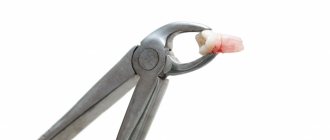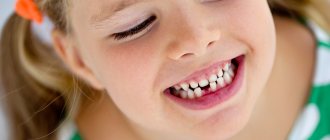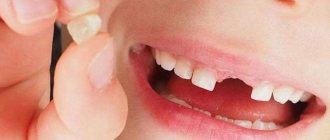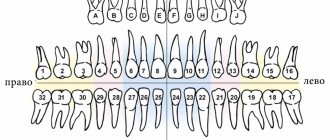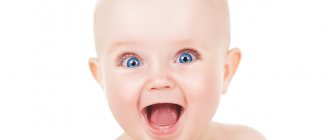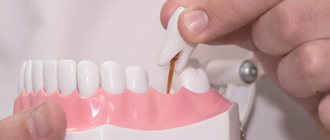Milk teeth are bone formations that are designed for mechanical processing of food in order to prepare it for subsequent digestion. They also influence diction and make the child’s speech correct and clear. In terms of their anatomical structure, they are in many ways similar to permanent ones, but they all have some differences. Among them:
- the coronal part is smaller;
- the thickness of enamel and dentin is less (from 0.6 to 1 mm);
- reduced degree of mineralization;
- no immune zones;
- the pulp volume is large;
- dental canals are shorter;
- poorly developed tubercles in the closure zone.
As for the number of root canals, their number remains unchanged.
The roots of baby teeth are slightly inclined. This is explained by the fact that the rudiments of permanent units are located above them.
It is a mistake to believe that children's teeth do not have roots. But this is what many adults think when they look at their children’s fallen teeth. In fact, by the time of prolapse, the formations located in the alveoli are almost completely resolved.
What are the dangers of premature removal of baby teeth?
Speech disturbances, inhibited bone growth and unnecessary pain are just some of the unpleasant consequences of not properly caring for baby teeth. Some parents mistakenly believe that there is no need to worry about baby teeth if they fall out anyway. Premature loss of primary teeth, that is, 3-4 years before the date of their physiological loss, in adulthood leads to unpleasant consequences - crowding or various types of malocclusion.
Baby teeth have a specific structure and are very susceptible to caries. Their premature loss is most often caused by advanced caries or mechanical injuries. If primary teeth begin to deteriorate, inflammation of the pulp quickly occurs, and then inflammation easily occurs with complications around the periapical tissues or abscesses. In such cases, it is often impossible to perform root canal treatment. All that remains is to remove the baby tooth. The whole process of pain and treatment exposes the baby to many troubles, and it is worth protecting him from this.
What to do in the first minutes if a child has a broken tooth?
First, calm down yourself and calm your child. If you have something cold on hand, it is good to immediately apply a compress to the injury site to relieve pain and prevent severe swelling (if the injury is not open).
For an open wound, clean it of large contaminants and cover it with a sterile gauze pad. Time is very important! The most important thing is to get to the dentist as quickly as possible! The doctor will conduct an examination, take an x-ray to see all damage to the hard and soft tissues surrounding the tooth and rule out a fracture of the jaw bones, as well as carry out the necessary treatment.
In the future, such teeth require dynamic observation at a time determined by the dentist. With timely treatment and regular monitoring, the prognosis is favorable.
Why do baby teeth deteriorate?
Damage to a baby tooth most often occurs due to caries in early childhood. This disease can take different forms. The wrong way to feed a baby can lead to bottle tooth decay. If the baby falls asleep with a bottle in his mouth or is given formula or sweet tea after waking up at night, then streptococcal bacteria develop in the mouth during sleep. They are the ones who contribute to the occurrence of this variant of the disease.
In older children, two and three years of age, circular caries is observed. This is the name of the early stage of caries with an acute course. It first begins to attack the front teeth, most often in the upper jaw and symmetrically on both sides, and then leads to pulp complications. A tooth with a damaged crown is not suitable for root canal treatment and must be removed. Leaving a baby tooth damaged by caries is dangerous because it is an inflammatory source in the child’s mouth.
Another very common cause of loss of baby teeth is childhood trauma. It is not uncommon for a child to lose teeth due to a fall. One of the main reasons is that the design of primary incisors is completely different from permanent incisors. They are smaller, have shorter roots, and the jaw bones are more spongy. Children of certain ages are at greater risk of injury:
- the first and second years of life are when they are just learning to walk, but the older the child, the greater the risk;
- later, at the age of four to six, other activities appear: playing with a ball, running, climbing.
So it is not difficult to lose a tooth. Often, the premature loss of baby teeth in children is not given much attention. However, the roots of an extracted baby tooth are usually not completely resorbed, and the root of a permanent tooth is still in the early stages of development. This has quite serious consequences, so the indications and contraindications for removal should not be ignored.
How temporary teeth are removed
Like any other medical procedure, tooth extraction has a clearly developed scheme and is carried out in several stages:
- Local anesthesia is the most common form of anesthesia. Specialists turn to more serious methods (general anesthesia) only in extreme cases: pathologies of the child’s psyche, purulent processes in the oral cavity, an allergic reaction and a history of individual intolerance to local anesthetics;
- Application of forceps to the crown;
- Rocking baby tooth;
- Its removal from the hole;
- Removal of fragments and granulations remaining in the socket;
- Packing the wound surface.
In order for both the doctor and the little patient to feel comfortable, parents must prepare the child and explain to him the importance of this procedure. Mental preparation is an important aspect of treatment.
Removal of baby teeth in children
It all depends on the number of lost baby teeth, their location in the jaw and how much time is left before the permanent tooth erupts. If it is three or four years, the more likely it is that the permanent tooth will be delayed or will not grow. The hard and compact bone tissue formed above the tooth germ will be difficult for him. The opposite is true when the time to a supposedly permanent dentition is quite short. Then the eruption of the permanent tooth usually occurs earlier than it would have happened naturally.
Premature loss of primary teeth can also interfere with alveolar bone growth. A child who does not have teeth cannot bite properly, and the forces generated during this activity are not transmitted to the bones and muscles, which does not contribute to their proper development.
Losing two baby teeth on one side, such as the fourth and fifth, can lead to other consequences. With such extensive missing teeth, the occlusal forces between teeth that shape and guide the growth of the alveolar bone are compromised. Thus, growth is uneven and is expressed in the vertical layering of bone where there are no teeth.
Premature loss of a molar, that is, the primary five, always leads to an internal (i.e. forward) displacement of the fixed six. This is a common problem that causes the dental arch to shrink. As a result of this phenomenon, there may not be enough space for other molars. Consequently, crowding of teeth occurs, this feature looks unsightly when there is no room for the canine tooth and it grows outside the dental arch or does not grow at all because due to lack of space, it gets stuck in the bone.
Premature loss of incisors and primary canines, that is, the upper front teeth, contributes to poor jaw bone development, which can lead to malocclusion. For example, if the jaw is underdeveloped compared to the lower jaw, an anterior transverse bite will form (the lower front teeth will overlap the upper ones).
Speech problems may occur in children with severely defective primary teeth, especially the front incisors. Such deficiencies do not contribute to the correct position of the tongue on the palate, so there is a possibility of interdental lisp. As a rule, after the removal of a baby tooth, a child needs 1-2 years of visiting a speech therapist or dentist.
Missing teeth and speech defects not only affect health, but also have a psychological aspect: the child may have low self-esteem, be secretive or shy because of his appearance. Children's baby teeth are truly worth caring for. Oral hygiene is equally important at every stage of life.
What does a lost baby tooth look like (photos below)?
The difference between a baby tooth and a permanent tooth
Many parents, out of ignorance, tend to think that baby teeth do not have roots at all. At the same time, some mothers and fathers are horrified when a developed root system is not found on a lost baby tooth, believing that part of the tooth remains in the child’s gum. Brief information about what a lost baby tooth looks like will help dispel all the myths. A photo of the removed bone formation will provide the best idea of it.
Temporary incisors are identical to permanent incisors in structure, but differ in smaller crown sizes, thinner enamel and the presence of rather wide canals and large pulp. Despite numerous misconceptions, the root system of a baby tooth is present and ensures the proper performance of the functions of grinding food and forming a normal bite.
Pulled out milk tooth with root
The absence of roots in a fallen baby tooth is explained by their resorption at a certain stage of a person’s life to allow permanent bone structures to erupt, which is the norm.
Treatment of baby teeth by a doctor
Just like adults, children's baby teeth are susceptible to caries. The treatment in the clinic is similar to the treatment of permanent teeth, with the difference that you can use special plastic fillings for baby teeth in white or many other colors. In addition to the temperature, premature removal of a baby tooth can distort the growth of the upper or lower jaw, cause insufficient space in the arch for permanent teeth, or damage their buds. This is why it is so important that the baby tooth remains in the mouth until natural tooth replacement occurs.
As permanent teeth erupt, baby teeth tend to move around a lot. This may be accompanied by purulent inflammatory processes. Then it is better to remove the baby tooth. When the first permanent molars appear, it is worth considering dental fillings. The procedure consists of fixing them with a special varnish that protects them from rotting. The treatment is completely non-invasive and painless. The optimal time for placing fillings is about 6 years.
What if a child has a broken tooth?
First, it is important to understand how serious the situation is? If the front baby tooth is broken at the root, the dentist will most likely recommend removing it. If only a piece of a tooth (deciduous or permanent) has broken off, then removal can be avoided and an attempt can be made to restore it. The pediatric dentist will use filling material or an artificial crown to restore the missing part of the tooth. With severe trauma, the tooth may go deep into the gums (the so-called “impacting”), and initially it may seem that the child has broken the tooth at the very root. Therefore, it is very important to contact your pediatric dentist immediately. If the injury was so severe that the entire tooth fell out of the socket (knocked out), then, if possible, you need to find the tooth and get an appointment with the dentist as soon as possible, taking the knocked out tooth with you. In most cases, permanent teeth can be “implanted” in their original place (replanted). The knocked-out tooth must be placed in warm milk or saline solution, or directly into the child’s mouth, and the sooner your child is in the dentist’s chair, the higher the likelihood of such a tooth being implanted (the clock counts). Baby teeth cannot be replanted.
What to do if a baby tooth falls out?
For the first 2-3 hours after the removal of a baby tooth, eating should be excluded, so before visiting the dental office or starting the procedure at home, you should feed the child. You also need to take care of how to treat the wound if your child has lost a tooth.
To rinse the mouth, you can use both ready-made solutions (for example, Rotokan) and home-made analogues.
An excellent disinfectant folk remedy is a decoction based on chamomile or sage, but it is recommended to use them only when chilled, because hot liquid interferes with the normal healing of the wound. This warning also applies to eating hot food.
After rinsing, you can apply a piece of cotton wool soaked in the same solution to the hole and leave for 15-20 minutes. After the specified time, the tampon must be removed, after which it is recommended to provide absolute rest to the wound. For the next three days, it is better to do without rinsing the mouth and spitting, because it is extremely important to keep the formed blood clot in the wound.
Why do baby teeth fall out and in what cases are they removed?
Milk units, like permanent ones, have roots. However, they are short and can dissolve on their own. The natural loss of time units occurs precisely for this reason. At the same time, the tooth begins to loosen and falls out. This process usually does not cause discomfort to children.
However, sometimes babies lose teeth due to injury. With a strong impact, the tooth element is damaged and falls off. If by this time the root has not dissolved, then it remains in the hole. Removing temporary teeth is highly undesirable, since it entails a change in the bite. A tooth is pulled out if the following indications are present:
- due to the injury, a sharp fragment remains, which causes discomfort,
- caries has led to the destruction of most of the milk unit,
- caries spreads deeper, there is a danger of damage to the rudiments of permanent teeth,
- diagnosed with pulpitis,
- a tumor was discovered on the gum,
- a loose tooth causes discomfort to a child,
- a temporary unit prevents the growth of a constant one.
Do you need pain relief?
Anesthesia when removing temporary units is necessary when they are pulled out before the roots are reabsorbed. Without anesthesia, the procedure will cause pain to the child, since there are many nerve endings in the oral cavity. When removing, the following anesthesia methods are used:
- General anesthesia. They are used only if the child has mental illness or other remedies do not work on him.
- Local anesthesia with spray or gel. The method is suitable if the unit begins to wobble and does not cause severe discomfort.
- Anesthetic injection. The injection is given in the gum. Anesthesia lasts longer than when using gels and sprays, and has a more pronounced analgesic effect.
Causes of loss of baby teeth
As a rule, at the age of 5, a child’s first milk tooth begins to loosen. This is an absolutely natural, physiological process that happens to every child: the root of a baby tooth dissolves, the tooth begins to be held in place only by the gums, gradually loosening and eventually falling out. However, if the tooth fell out much earlier, this situation can no longer be considered normal. Baby teeth fall out prematurely due to:
- Tooth injuries
- Vitamin deficiency
- Rakhita
- Diabetes
- some genetic diseases
In most cases, these diseases can be treated, the main thing is to seek medical help in time.
If a tooth falls out a year or more ahead of schedule, this can lead to improper development of the bite and slow jaw growth. In this case, long-term orthodontic treatment will be required.
In addition, parents should pay attention to the following points:
Long process of falling out
If a child's baby tooth becomes loose for a long time but does not fall out, it can cause discomfort to the child, preventing him from eating and speaking. The gums around the tooth may become inflamed and painful.
Deterioration of the child's well-being
If a child has a loose tooth and, as a result, the temperature rises, loss of appetite, nausea and vomiting occur - first of all, seek advice from a pediatrician, and secondly - from a dentist.
Features of the period.
By the age of 9, the child’s upper and lower incisors and first permanent molars erupt in the child’s dentition. The dentition still contains primary canines and molars. The permanent incisors are normally positioned evenly in the dentition without “protrusion” or “sagging” to the side.
By the age of 10, the process of formation of the roots of permanent teeth that have already erupted in the oral cavity (first molar, central and lateral incisors) is completed. These teeth are “stabilized” in the bone tissue.
At 9–10 years of age, the roots of the 4th milk tooth (1st primary molar) are reabsorbed and replaced with the 4th permanent tooth (1st premolar) first on the upper and then on the lower jaw. From 10 to 12 years of age, the roots of the 5th primary tooth (2nd primary molar) and primary canine begin to be reabsorbed and replaced by the 2nd premolar and permanent canine, respectively. The permanent canine is the last one to erupt.
By the age of 12–13 years, the replacement of baby teeth with permanent teeth is completed. There should be 24 teeth in the dentition: 12 on each jaw.
The child is 9 years old: his upper and lower permanent central and lateral incisors and first molars have erupted. The milk chewing teeth and fangs are still motionless, although the resorption of their roots has already begun.
